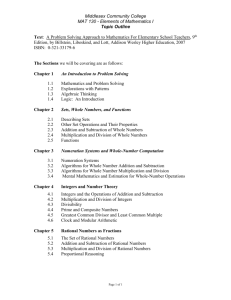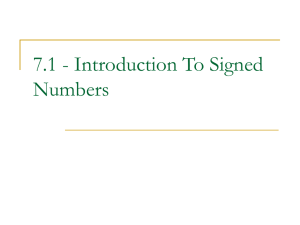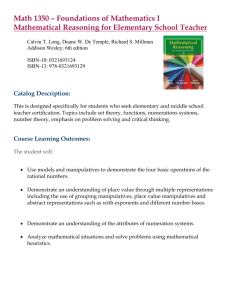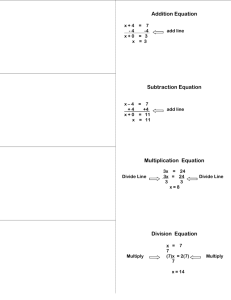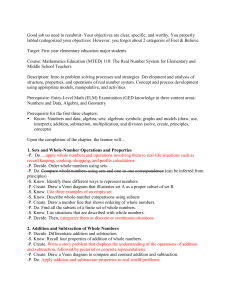Chapter 2 - Orange Coast College
advertisement
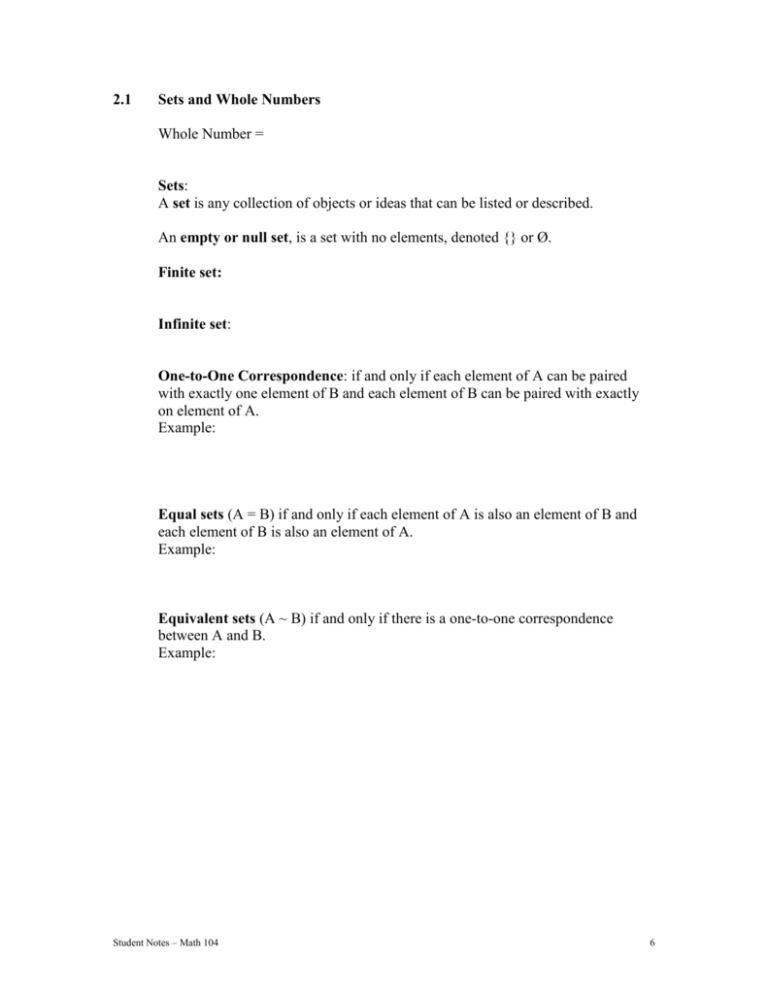
2.1
Sets and Whole Numbers
Whole Number =
Sets:
A set is any collection of objects or ideas that can be listed or described.
An empty or null set, is a set with no elements, denoted {} or Ø.
Finite set:
Infinite set:
One-to-One Correspondence: if and only if each element of A can be paired
with exactly one element of B and each element of B can be paired with exactly
on element of A.
Example:
Equal sets (A = B) if and only if each element of A is also an element of B and
each element of B is also an element of A.
Example:
Equivalent sets (A ~ B) if and only if there is a one-to-one correspondence
between A and B.
Example:
Student Notes – Math 104
6
A is a subset of B (A B) if and only if each element of A is also an element of
B.
Example:
A is a proper subset of B (A B) if and only if A is a subset of B and there is at
least one element of B that is not an element of A.
Example:
n(A) = the number of elements in the set A.
Definition of less Than and Greater
For whole numbers a and b and sets A and B, where n(A) = a and n(B) = b, a is
less than b, symbolized as a < b, if and only if A is equivalent to a proper subset
of B. Note that a is greater than b, written a > b, whenever b < a.
Student Notes – Math 104
7
2.2
Addition and Subtraction of Whole Numbers
Union of two sets A and B is the set containing every element belonging to set A or set B
and is written A B.
Intersection of two sets A and B is the set containing every element belonging to both
set A and set B and is written A B.
Sets are said to be disjoint if and only if their intersection is the empty set.
Definition of Addition of Whole numbers
In the addition of whole numbers, if A and B are two disjoint sets, and n(A) = a and
n(B) = b, then a + b = n(A B). In the equation a + b = c, a and b are addends, and c is
the sum.
Properties of Addition of Whole Numbers
Closure property
Identity property
Commutative property
Associative property
Definition of Greater than and Less than for Whole numbers
Given whole numbers a and b, a is greater than b, symbolized as a > b, if and only if
there is a whole number k > 0 such that a = b + k. Also, b is less than a (b < a),
whenever a > b.
Student Notes – Math 104
8
Modeling Subtraction
Subtraction as taking away a part of a length
Example:
Subtraction as the Inverse of Addition.
Here you are looking for the missing addend
Example:
Comparison Model
How much more is one than the other?
Definition: In the subtraction of the whole numbers a and b, a – b = c if and only if c
is a unique whole number such that c + b = a. In the equation, a – b = c, a is the
minuend, b is the subtrahend, and c is the difference.
Comparing Properties (Subtraction vs Addition)
Which properties do not hold? Give counterexamples.
Student Notes – Math 104
9
2.3
Multiplication and Division of Whole Numbers
Using Models and Sets to Define Multiplication
Area Model:
Repeated Addition:
Set Language
The Cartesian product of two set A and B, A x B (read A cross B) is the set of all
ordered pairs (x,y) such that x is an element of A and y is and element of B.
Def. Of Multiplication of Whole Numbers
In the multiplication of whole numbers, if A and B are finite sets with a = n(A)
and b = n (B), the a x b = n(A X B). In the equation a x b = n(A X B), a and b are
called factors and n(A X B) is called the product.
Properties of Multiplication of Whole Numbers
Closure property
Identity property
Commutative property
Associative property
Zero Property
Distributive property of
Mult. over addition
Student Notes – Math 104
10
Modeling Division
Finding How many subsets Model.
Example: 300 25
Finding how many in each subset.
Example:
.
Using Multiplication to Define Division
Division as the Inverse of Multiplication.
Example:
Division as Finding the Missing Factor.
Example. 35 7 ?
Definition of Division
In the division of whole numbers a and b, b ≠ 0, a b c if and only if c is a unique
whole number such that c x b = a. In the equation, a b c , a is the dividend, b is the
divisor, and c is the quotient.
Check to see which properties hold for division.
Student Notes – Math 104
11
2.4
Numeration
Definition of Numeration System
A numeration system is an accepted collection of properties and symbols that enables
people to systematically write numerals to represent numbers
Use Egyptian symbols to represent 5642
Different Bases
Base Ten
What does 1456 really mean?
(1 x 1000) + (4 x 100) + (5 x 10) + (6 x 1)
The largest digit in any column will be The smallest digit in any column will be The number of possible digits in any column is –
Student Notes – Math 104
12
We can establish values by position:
thousands hundreds tens
ones
2
0
1
5
sixtyfour
eights
ones
One
tenth
.1
One one- One onehundreth thousandth
0
2
0neeighth
One
sixtyfourth
Base eight
512
1/512
Example:
What would 258 be in base 10?
What would 103 be in base 8?
How would we do this in other bases?
Student Notes – Math 104
13


